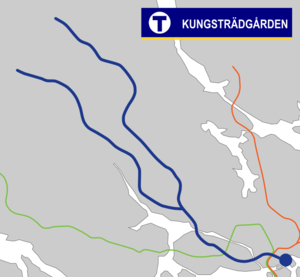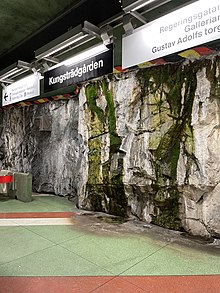Kungsträdgården metro station
| Stockholm metro station | |||||||||||||||
 | |||||||||||||||
| General information | |||||||||||||||
| Location | Norrmalm, Stockholm | ||||||||||||||
| Coordinates | 59°19′50″N 18°04′24″E / 59.33056°N 18.07333°E | ||||||||||||||
| Elevation | −29.3 m (−96 ft) AMSL[1] | ||||||||||||||
| Owned by | Storstockholms Lokaltrafik | ||||||||||||||
| Distance | 0.2 km (0.12 mi) from Kungsträdgården[a][1] | ||||||||||||||
| Platforms | 1 island platform | ||||||||||||||
| Tracks | 2 | ||||||||||||||
| Construction | |||||||||||||||
| Structure type | Underground | ||||||||||||||
| Depth | 34 m (112 ft) | ||||||||||||||
| Accessible | Yes | ||||||||||||||
| Other information | |||||||||||||||
| Station code | KTG | ||||||||||||||
| History | |||||||||||||||
| Opened | 30 October 1977 | ||||||||||||||
| Passengers | |||||||||||||||
| 2019 | 9,850 boarding per weekday[2] | ||||||||||||||
| Services | |||||||||||||||
| |||||||||||||||
| |||||||||||||||
Kungsträdgården is a station of the Stockholm Metro, located in the district of Norrmalm. It is the end station of line 10 and line 11, and was opened on 30 October 1977, as the 91st station and part of the one-station extension from T-Centralen.[3] The platform is located approximately 34 meters underground. The station features relics rescued from the many buildings pulled down during the redevelopment of central Stockholm during the 1950s and 1960s throughout the station.[4]
The entrance to the station was originally intended to be in the park Kungsträdgården, but due to the Elm Conflict in 1971 these plans had to change.

Flora and fauna
[edit]The station is notable for its unique plant, animal and fungal life. It is the only place in Scandinavia where the Lessertia dentichelis spider can be found. The cave-dwelling spider has lived on the station's walls ever since it opened for service in the mid-1970s, but scientists do not know exactly how it got there. Presumably, it traveled on machines and excavation equipment from Southern Europe that was used during the construction. There is also moss growing on the walls that was previously thought to be extinct in the Stockholm region.[5]
In 2016 a team of scientists conducting a survey of the metro's wildlife discovered two previously unknown species of fungi covering the station walls. Upon closer analysis the fungi turned out to be from a previously unknown genus, with unique DNA compositions.[6]
Notes
[edit]- ^ The kilometre zero of the Blue line – commonly given as "Kungsträdgården" – is actually in a tunnel 200 m (660 ft) east of Kungsträdgården's platforms.
References
[edit]- ^ a b Alfredsson, Björn; Berndt, Roland; Harlén, Hans (2000). Stockholm under: 50 år – 100 stationer (in Swedish). Stockholm: Bromberg. pp. 98–99. ISBN 91-7608-832-4. SELIBR 7652820.
- ^ "Fakta om SL och regionen 2019" (PDF) (in Swedish). Storstockholms Lokaltrafik. p. 51. Archived (PDF) from the original on 27 December 2020. Retrieved 30 March 2021.
- ^ Schwandl, Robert. "Stockholm". urbanrail.
- ^ "Kungsträdgården".
- ^ "Ecosystem found in Stockholm subway" Sveriges Radio
- ^ Réblová, Martina; Hubka, Vit; Thureborn, Olle; Lundberg, Johannes; Sallstedt, Therese; Wedin, Mats; Ivarsson, Magnus (12 October 2016). "From the Tunnels into the Treetops: New Lineages of Black Yeasts from Biofilm in the Stockholm Metro System and Their Relatives among Ant-Associated Fungi in the Chaetothyriales". PLOS ONE. 11 (10): e0163396. Bibcode:2016PLoSO..1163396R. doi:10.1371/journal.pone.0163396. ISSN 1932-6203. PMC 5061356. PMID 27732675.


